Lite but Loaded – Co-WIN Automatic Weather Stations
10 August 2021
Olivia Lee Dexter Lee
The Community Weather Information Network (Co-WIN) is a collaboration among the Hong Kong Observatory (HKO), the University of Hong Kong and the Chinese University of Hong Kong. It provides an online platform with technical support to participating schools and community organizations, helping them install and manage their automatic weather stations (AWSs) and provide the public with observation data including temperature, relative humidity, rainfall, wind direction and speed, air pressure, solar radiation and UV index. Throughout the process, the participating students can learn skills such as instrument operation, weather observation and data analysis. The design of Co-WIN AWS is simple yet multifunctional. Let’s see how it differs from those standard AWSs implemented by HKO.
Temperature and Humidity
Co-WIN AWS employs resistance thermometer and hygrometer which are very small in size and are housed inside a solar radiation shield. The shield serves the same purpose as the Stevenson Screen at a standard AWS, which can protect the temperature and humidity sensors from direct exposure to sunlight and precipitation while allowing air to circulate freely.
For the standard AWSs at the Observatory, platinum resistance thermometers are installed inside the Stevenson Screen to measure dry bulb and wet bulb temperatures, from which the relative humidity can be computed. Some employ capacitive humidity sensor to measure relative humidity. According to the guidelines of the World Meteorological Organization (WMO), a standard Stevenson Screen should be installed between 1.25 and 2 metres above the ground. Co-WIN AWS is usually installed at the rooftop of school building, which provides better exposure and ventilation but at a relatively higher altitude above ground level.
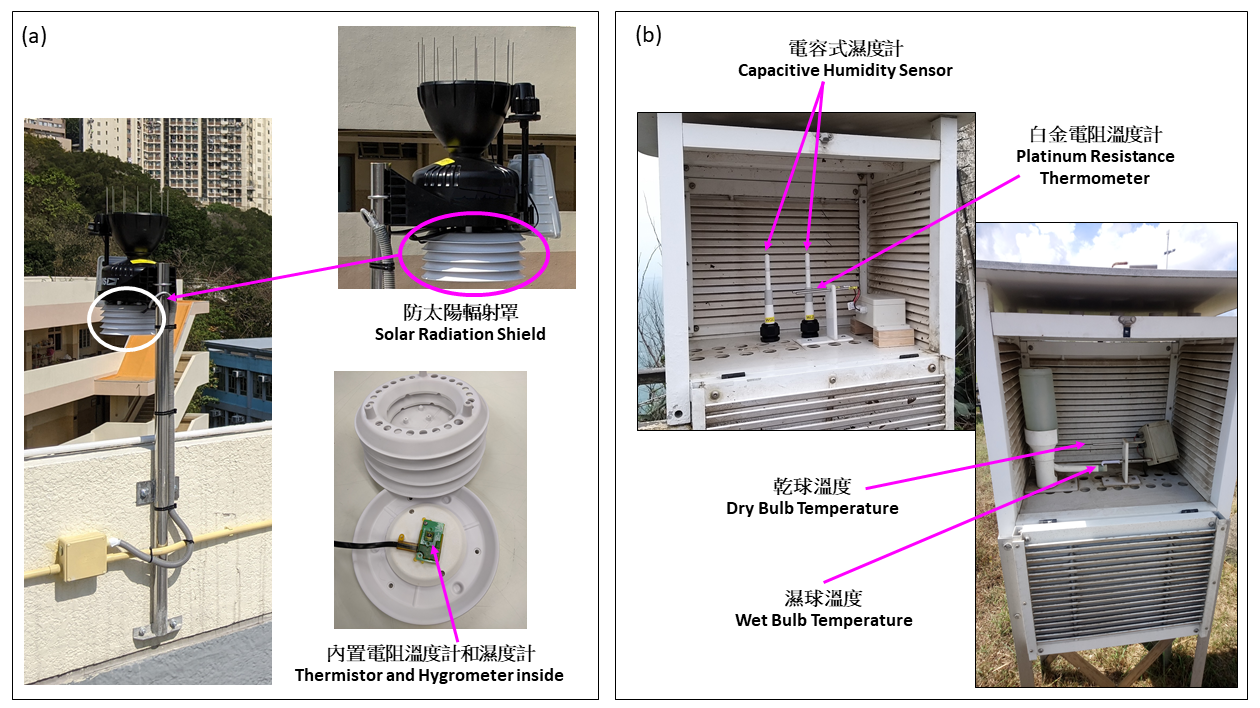
Rainfall
Both Co-WIN AWSs and standard AWSs use tipping bucket rain gauge to measure rainfall. Co-WIN’s tipping bucket rain gauge is located on top of the solar radiation shield. For a standard AWS, the rain gauge is usually installed on the ground and at a location with better exposure.
When raindrops fall into the tipping bucket rain gauge, they will gradually fill one of the two tipping buckets. When rain water reaches a certain level, the bucket, owing to the weight, will tip to the other side and drain away the rain water. When this happens, the other bucket is lifted and starts to be filled. The filling and tipping repeat. Rainfall can then be calculated by counting the number of times it tips.
Wind
Both Co-WIN AWSs and standard AWSs use cup anemometer and wind vane to measure wind speed and direction. Wind sensors at a standard AWS are mounted on a 10-metre-high wind mast equipped with a lightning rod according to WMO’s guideline to measure winds at 10 metres above ground. There should not be any tall obstructions near the site. On the other hand, due to restrictions of the venue, Co-WIN wind sensors are usually mounted on a mast of several metres high on the rooftop of school building. There may also be relatively tall buildings nearby.
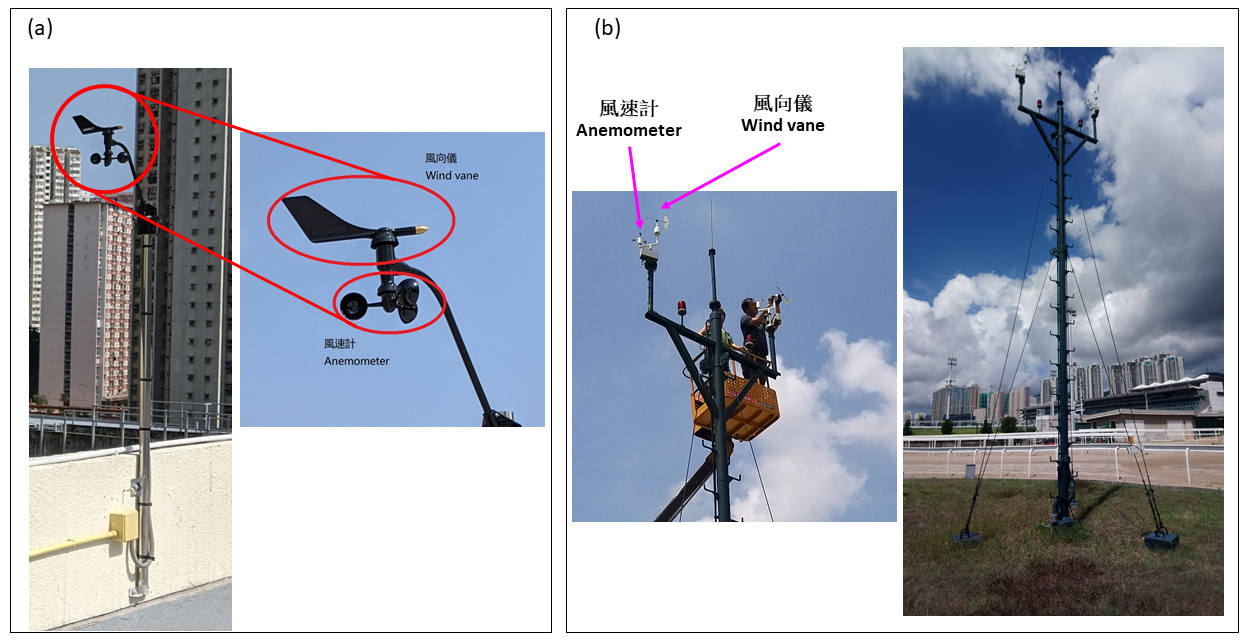
Pressure
The barometer of a Co-WIN AWS is of piezoresistive type and is embedded in a console, whereas an independent instrument such as a capacitive barometer is usually used to measure air pressure at a standard AWS.
Global Solar Radiation and UV Index
The solar radiation and UV sensors at a Co-WIN AWS are installed beside the tipping bucket rain gauge. A level indicator is attached to each sensor to ensure that the sensor is leveled. In this way each sensor has an unobscured hemispherical view of the sky for measurement of the global solar radiation and UV intensity. On the other hand, HKO employs more sophisticated pyranometer and UV radiometer. They are installed in designated AWSs where an open area is available for the solar radiation and UV intensity observation.
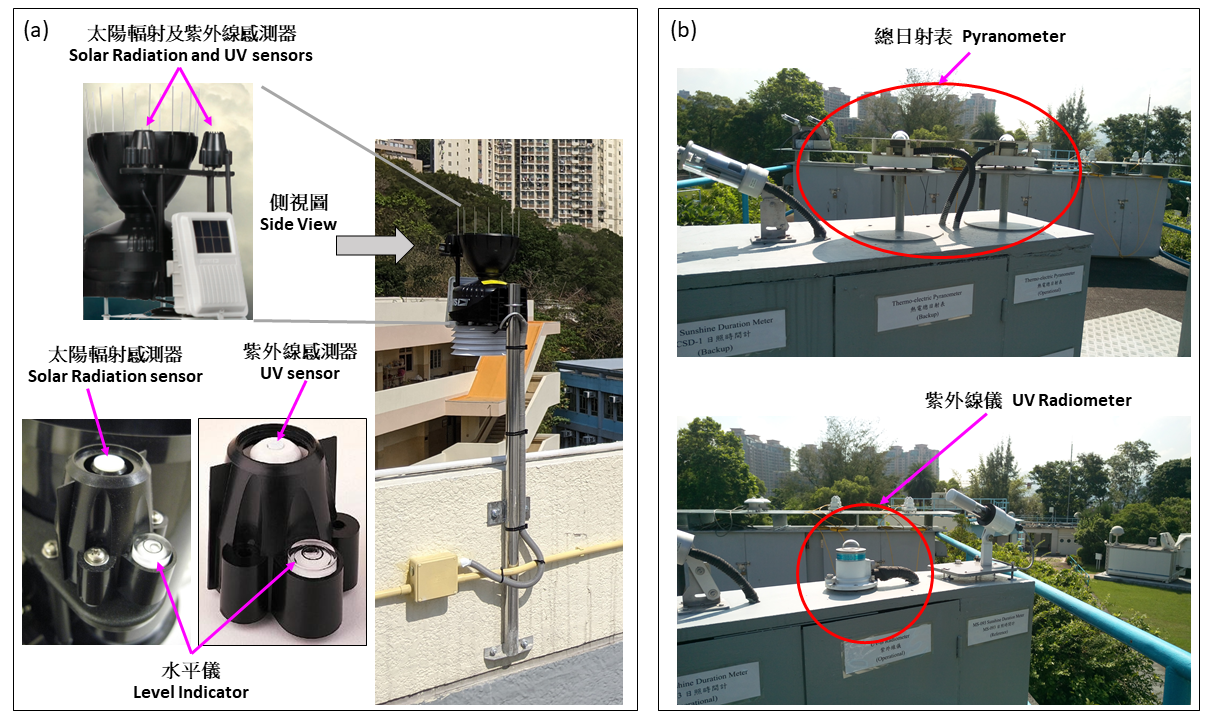
Site selection for AWS
No matter it is a Co-WIN AWS or a standard AWS, there are certain site selection requirements. The AWS should be located away from air conditioners, concrete floor, reflective surfaces and high walls. It should also be located at a place where air can circulate freely. Otherwise, temperature measurements may be affected. Furthermore, the rain gauge should not be installed at a location exposed to winds, lest the rainwater will be blown away by strong winds and cannot reach the rain gauge. The anemometer and wind vane should be mounted high enough to minimize blocking by surrounding structures.
In order to meet the above-mentioned site selection requirements of AWS, the Observatory endeavours to install AWS in open areas with no blocking by buildings nearby. Being constrained by the environment around school premises, Co-WIN members usually have to install AWS on the rooftop of school building instead.
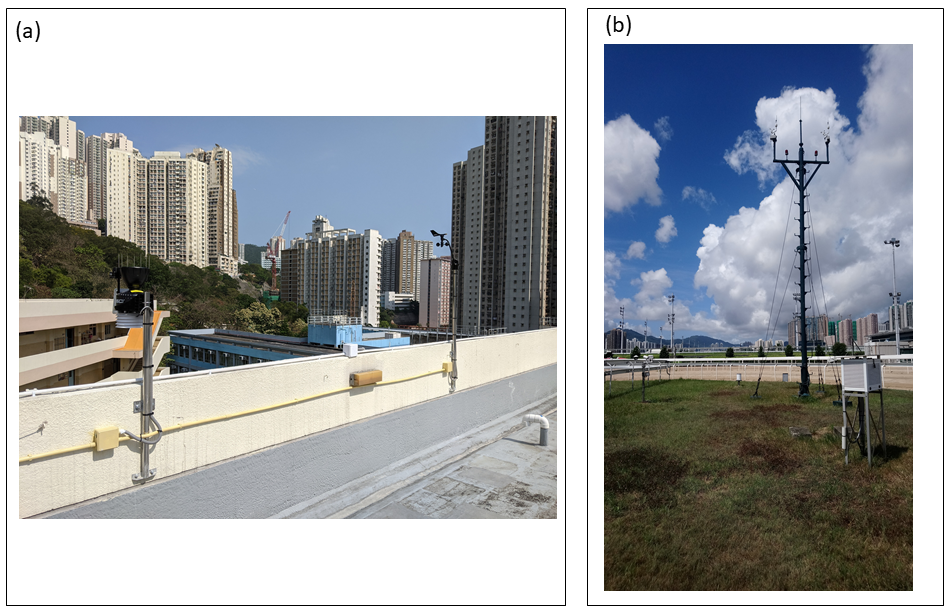
Weather Case
Co-WIN AWS is just like a ‘Lite AWS’. From past experience Co-WIN AWS is ‘Lite but Loaded’ – its performance in capturing weather situation is quite good compared with that of a standard AWS. For instance, we can take a look at the rainstorm event on 4 May 2021. Under the influence of a trough of low pressure, there was development of thunderstorms at the coast of Guangdong. Between 7 p.m. and 10 p.m., a thunderstorm bearing rainband over the northwest of Hong Kong moved southeast and crossed the territory (Figure 7).
Figure 8 shows the time series of one-minute rainfall and temperature recorded by a number of Co-WIN AWSs from 7 p.m. to midnight on 4 May 2021. We can clearly see the rise in rainfall and drop in temperature when the rainband crossed each Co-WIN AWS. Co-WIN AWS observations are of very good reference value and are similar to the variations of temperature and rainfall captured by the AWS at the Observatory Headquarters.
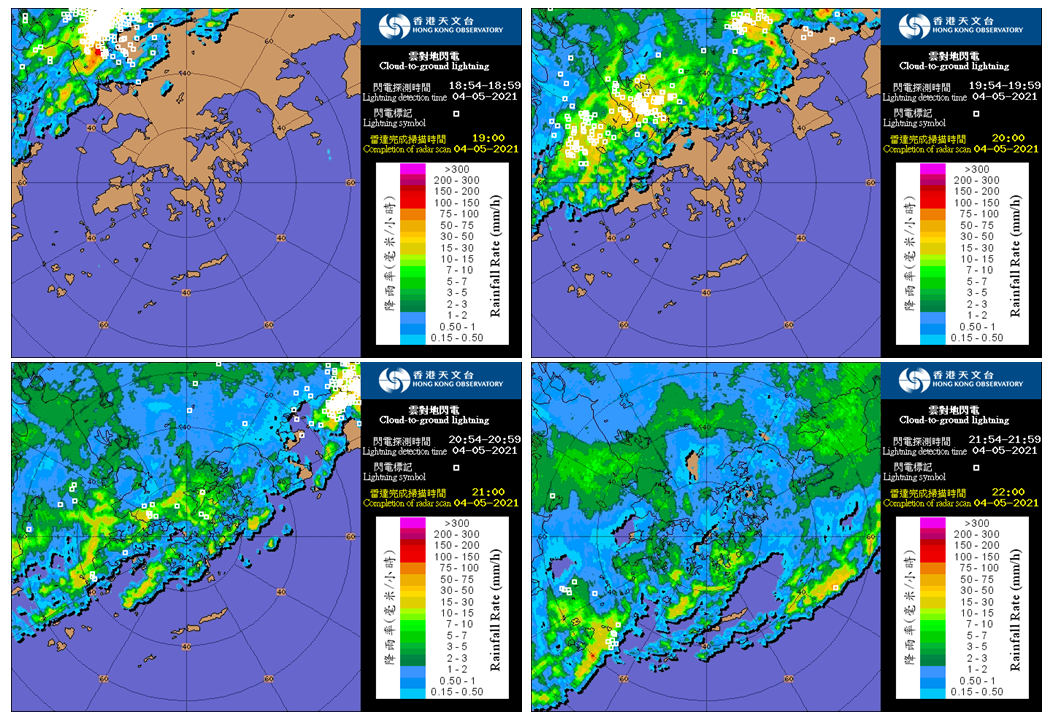
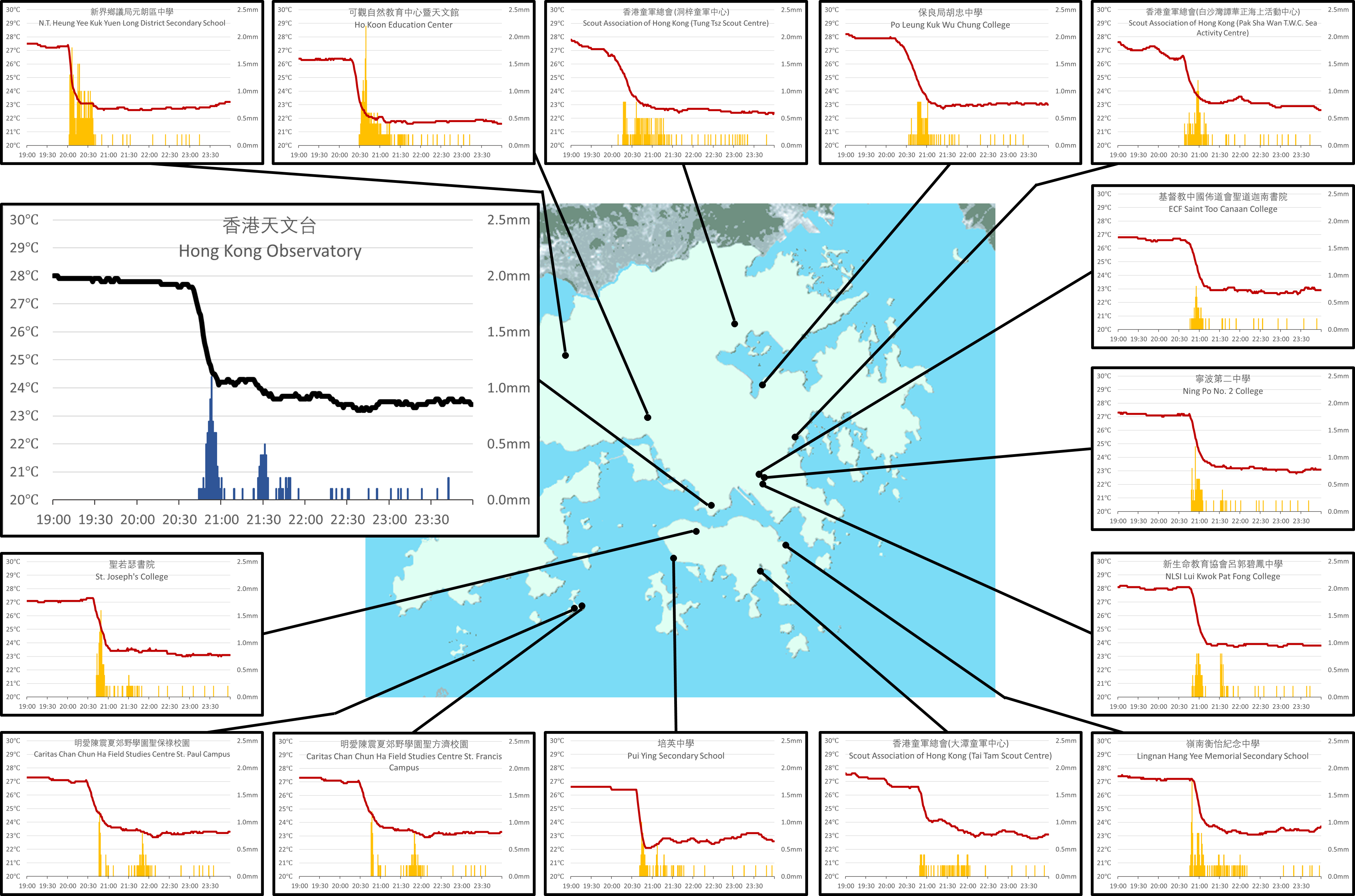
New generation of Community Weather Information Network Co-WIN 2.0
In recent years the Observatory has launched the new generation of Community Weather Information Network Co-WIN 2.0, featuring the use of microsensors for measurement of wind, temperature, relative humidity and so on. The sensors are housed inside a lamppost-shaped casing. Some of the components, such as the solar radiation shield, has been fabricated with 3D printing technology. In addition, Co-WIN 2.0 adopts open source alternatives for the microcontrollers and software, greatly reducing the hardware and software development cost. The idea behind Co-WIN 2.0 is that students can learn to build their own “DIY AWS” and develop the software program. To achieve this, the Observatory has also organized workshops for the students. With the Co-WIN 2.0 AWS as a prototype, HKO developed a bollard style AWS which has been put into operation for local weather monitoring in real time. Furthermore, in 2020, the Observatory successfully registered a patent in Hong Kong for the design of this bollard AWS.
Afterword
If you wish to take a look at the real-time weather data from Co-WIN AWSs, please visit the Co-WIN website (https://cowin.hku.hk/). Schools and organizations are also welcome to contact us and join the Co-WIN.
To add a bit of our history, Co-WIN was established in 2007 jointly by the HKO, the Department of Applied Physics of the Hong Kong Polytechnic University (PolyU), and the Hong Kong Joint-School Meteorological Association. Members provided real-time weather information to the public via the software and internet website developed by the PolyU. In 2017, the Institute of Future Cities of the Chinese University of Hong Kong (CUHK) joined Co-WIN and participated in the operation of the website. In 2021, the Department of Geography of the University of Hong Kong (HKU) took over from PolyU and CUHK to provide technical support for the software and operate the website.